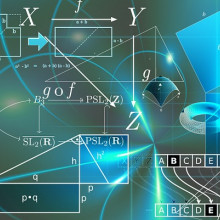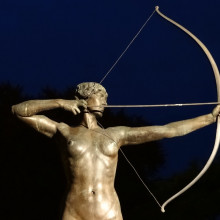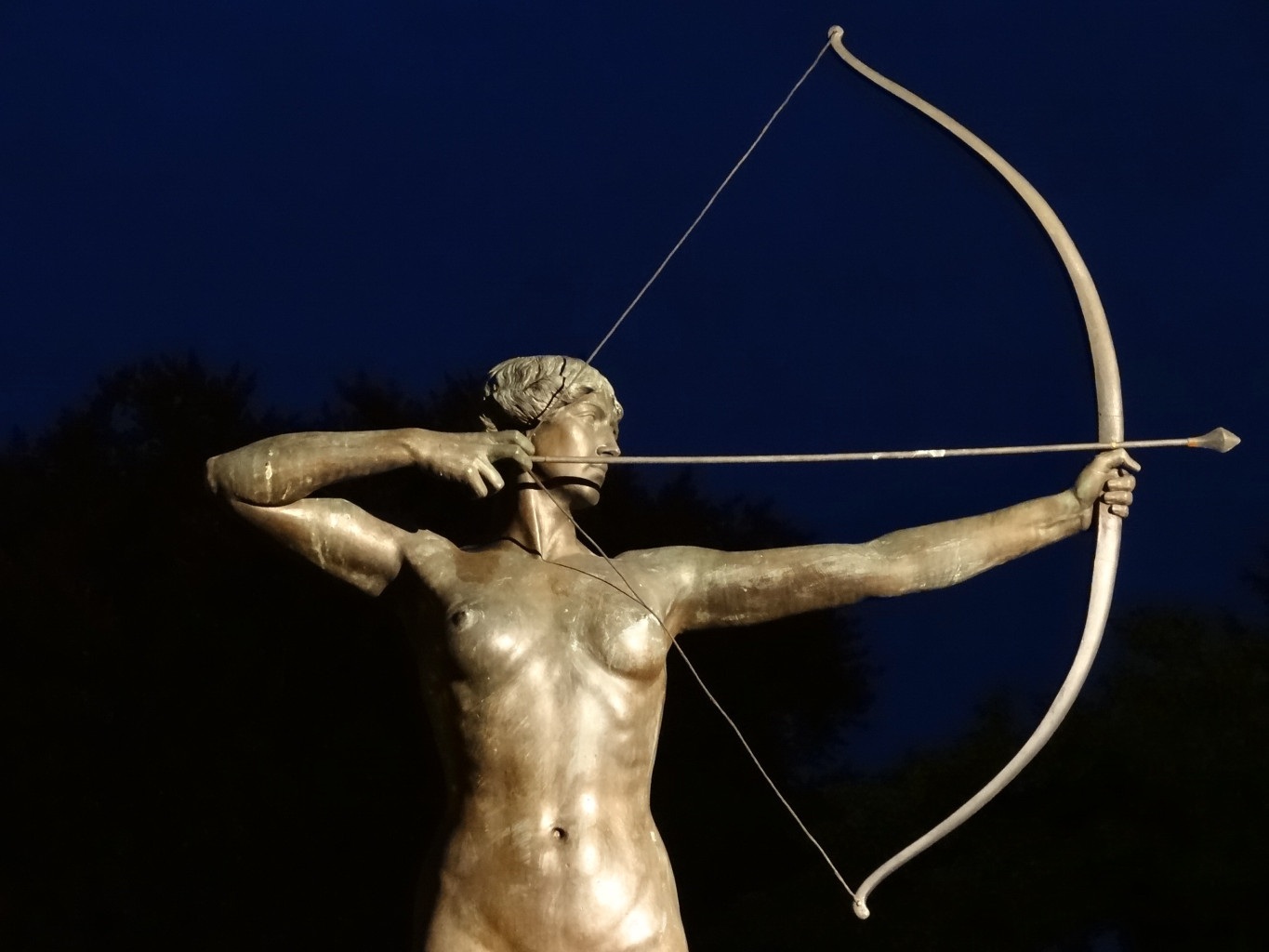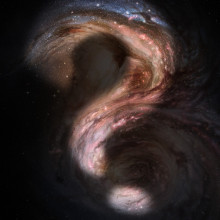Cosmic Quandries: The Origins of Time
One of the big questions in cosmology is what happened at the beginning of the universe? Astrophycisists are edging closer to answering this question - we can now look back to a fraction of a second after the Big Bang. But what happened before that still remains elusive and there are still many loose ends to tie up. In this episode of Naked Astronomy, Graihagh Jackson takes a look at the origins of time...
In this episode

01:08 - When time flows backwards
When time flows backwards
with Professor Huw Price, University of Cambridge
Time seems to have a forward direction - eggs don't unscramble for example but in physics, that's not the case. Graihagh Jackson spoke to Huw Price about this puzzling feature of physics starting with the conudrum that is the beginning of time...
Huw - It's a very good question. Many cosmologists now think that there is...
Graihagh - That's Professor Huw Price, Bertrand Russell Philosopher at Cambridge University and his research spans vast areas of science and metaphysics, including the philosophy of time.
Huw - This view goes back to the discovery that the universe is expanding (a discovery made in the 1920's). The logical implication of that is that there must have been a time when it was at minimum size and that's what we now think of as big bang and, on most views, that's the beginning of time - there's literally nothing before that. People often find that puzzling and ask the question "Well, what happened before the big bang" but, really, what you have to understand is the answer to that is nothing, because there is no before. And, interesting, that's and answer which was understood hundreds of years before modern cosmology by the great early philosopher, Augustin, who was a Bishop in North Africa in, I think, the 4th Century AD and he was interested in the theological puzzle of what God was doing before he created the Universe. And his answer to that was effectively the modern cosmological answer "well there was no before" because one of the things God created was time itself. He simply couldn't speak of what God was doing before he created the Universe and that's the same answer that you get in the big bang model in modern cosmology.
Graihagh - Basically, with the big bang, time was created. Time did not exist before the big bang because the big bang created time. Armed with the best physics of the 20th century, Albert Einstein came to very similar conclusions with his theory of relativity.
Consider time dilation i.e. the effect of mass on time.
Planet Earth's hefty mass warps time. It's why the clocks on orbiting satellites run a little slower and why astronauts on the International Space Station return having aged slightly less - although not by much: so after 6 months, Tim Peak would be about 0.007 seconds younger than he would had he lived on Earth. You'd don't have to be in space to experience it though - if you stood next to a big building or Ayres Rock, and time would run more slowly than if you stood on the flat plains somewhere, like in Cambridge.
That's an aside but the big picture here is that space and time is warped by mass and because at the big bang all the mass in the universe would have been contained in something smaller than an atom - a singularity - it would have brought time to a standstill.
Why then, did time and indeed this infinitely dense singularity, not stay like this forever? And what caused the universe to be in this state to begin with?
As a child, it's in built in us that there is a cause and an effect. Things just don't happen. Something makes them happen. Even when a magician pulls rabbits out of hats, trickery is suspected. Ergo, there must have been something before the singularity... Right?
Huw - So one answer you could give is that really physics tells us that there really is no such thing as causation. All we can do is just describe the great pattern as we find it in the world and in that pattern, in the big bang patterns of cosmology, it turns out that the first moment time - a kind of boundary in time - just as we might have a boundary in space. So that's one possibility; another possibility might be that we look for causes in the future as well as in the past and, if that's the case, then the best answer to the question - what caused the big bang - would be to look to the future and basically run the story backwards. The big bang has to happen because of how things are at later times.
Graihagh - How could you ever look to the future to discover what happened in the past?
Huw - In the physics, there's really no preference between the past and the future at a fundamental level. In deterministic models you can easily well run the equations in either direction and infer the past from the future, just as you infer the future from the past. Now, for creatures like us who happen to have a memory that works backwards, so we know more about the past than we do about the future, it's natural to have a causation that we think of as running forwards. That's the direction in which we deliberate, in which we act on the world, but physics seems to suggest that that's more a product of our viewpoint on the world than it's a product of anything that's fundamentally there in nature.
Graihagh - If I get this right then... Something I do tomorrow could have caused something that I did yesterday?
Huw - Well, that way of looking at things, from the point of view of physics, is just as valid as the ordinary way of looking at things. Now for many purposes it's much better to look at things from a human point of view than from the point of view of fundamental physics and, from the human point of view, the useful notion of causation is the one that does work forwards. That's the one when we're deliberating about, you know, what to have for lunch or something and we're thinking about what the effects in the afternoon might be... But physics doesn't care about that sort of thing.

07:13 - Time's arrow
Time's arrow
with Dr Julian Barbour, Independent Physicist
Time seems to have a clear and irreversible direction. This is what astrophysicist  Arthur Eddington coined as time's arrow. It's a big problem in physics. All laws of physics dictate that time works both ways - backwards and forwards - but in everything we observe, time moves forward. The problem is something phycists have been grappling with for over 100 years, that is until earlier this year when Julian Barbour did some modelling, as he explained to Graihagh Jackson...
Arthur Eddington coined as time's arrow. It's a big problem in physics. All laws of physics dictate that time works both ways - backwards and forwards - but in everything we observe, time moves forward. The problem is something phycists have been grappling with for over 100 years, that is until earlier this year when Julian Barbour did some modelling, as he explained to Graihagh Jackson...
Julian - If we are right, it may be that we have succeeded in solving one of the really outstanding problems in physics...
Graihagh - Julian Barbour, Physicist.
Julian - Well, first of all it was a publication with two of my collaborators, Tim Kotsolvsky and Flavia Nakarti and we attached the problem that is called - well it's the origin of the arrow of time. And this has been a great problem for 120 years or so, since the time of the great Austrian Physicist Ludvic Boltsleim.
Graihagh - And that's when he did some work on The Second Law of Thermodynamics - right?
Julian - That's right. It's a very unsatisfactory...
Graihagh - The Second Law of Thermodynamics refers to entropy and how disordered - the universe is becoming. At the beginning, the universe was extremely ordered - everything smushed into something smaller that the atom - but as the universe expanded, everything became a bit more complex and disorganised with the advent of galaxies, stars, planets, asteroids, and even humans all being added to the mix. The second law of thermodynamics just says that things will just get more chaotic as time moves forward, from low entropy to high...
The problem is this: our laws of physics just can't make low entropy conditions that we need for the thermodynamic arrow of time. They just don't work unless you add a series of messy equations to the end and, actually, scientists don't like this. That's because it links to the idea that one day they'll be a theory of everything - one simple equation that explains, well, everything. And this 'special' initial, messy condition of low entropy just doesn't fit the mould.
And so it's no wonder that Julian and many other physicists find this all just a bit troublesome.
Julian - It's very unsatisfactory that we have a wonderful law of nature, particularly gravity, but we seem to have to add, in addition, very special initial conditions to get what the Universe looks like. Because the Universe is fairly special; we have these processes which all seem to point in the same direction - this extraordinary uni-directionality - all these arrows, all pointing in the same direction. It seems very unsatisfactory that we can't get that behaviour without making some ad-hoc, very special assumption.
Graihagh - So you've built a model that could potentially overcome this idea of having very special, initial conditions?
Julian - Yes, that's what we've done. Now, this is only a first step but it seems to be completely new and the remarkable think is, all we've done is really, actually look at dear old Newton's law of gravity.
Graihagh - They've got a super computer and repeatedly simulated what a 1000 particles would do under the laws of Newton's gravity, not thermodynamics. And guess what? They evolve into a low complexity state roughly analogous to the Big Bang. Thus the sheer force of gravity - not thermodynamics - is what draws the bowstring of time's arrow...
Julian - What we have thereby shown is that in every single solution of Newton's theory - this actually happens. There is an arrow of time and it's nothing whatever to do with a special condition because no special conditions have been imposed. It generally has the potential to change the whole way we think about this problem of the arrow of time.
That's all very well and good but what's this got to do with the beginning of time, I hear you ask? Well, firstly, it means that two futures evolve from one past...
Julian - Well, effectively the solution divides into two universes really. They are qualitatively similar but they are quantitatively different. So you and I wouldn't be talking to each other in the other universe - you and I are on this side of that central region. There could be intelligent beings - I hope we're intelligent - on the other side of that central region talking about the mystery of the arrow of time.
Graihagh - That's not all. If this holds true, then the big bang wouldn't be the cosmic beginning of time but rather a phase in a timeless and eternal universe, i.e. there is no beginning of time...
Julian - But, of course, I have to emphasise this is still very much early days. This is just a simple model. Basically, if we're going in the right direction, we may be able to explain much more just on the basis of the law without adding any additional ingredients like a special initial condition, followed by inflation, and special types of matter and things like that. Now this is just a hope at the moment but it's an indication that we might be going in the right direction. In which case, it could be a very big advance and it could lead to quite new ways of looking and thinking about the universe.

14:06 - Could time be infinite?
Could time be infinite?
with Professor Huw Price, University of Cambridge
The idea that there is no beginning of time - time is infinite - is not an entirely new idea though but, all the same, the idea of infinity, is something that baffles most. Philosopher Huw Price unpicked the meaning of infinite with Graihagh Jackson...
Huw - Well there are cosmologists who think that the big bang wasn't really the beginning. That before the big bang there were other cycles, perhaps cycles of expansion and contraction and, in that case, there is something that happened before the big bang. There was something like a big crunch, when all the matter in some previous cycle of the universe and then, instead of forming what this is called a singularity, what happened was that instead of collapsing like that, the matter bounced and so people talk about the big bounce rather than the big bang.
Graihagh - In this view, one could talk of a Big Crunch - the universe collapsing or re-collapses, back into a singularity and reforming another universe starting with another big bang. I tried to think of a story or an analogy to explain this but I don't think there's anything like this in existence. Huw, on the other hand, had a good one to hand...
Huw - Well if you imagine a spring oscillating so it's expanding and contracting so. In these models, the long term history of the universe is something like that - it's a cycle of bounces and collapses.
Graihagh - So then, that means time is infinite and there is no beginning of time if it's continually contracting and expanding though?
Huw - Yes, exactly and that's, I think, regard by some people as an attraction of that model that you don't have a moment in time that's distinguished by being the first one.
Graihagh - But that brings us back round to this question, what would have caused the first one?
The way I think of it right is like a series of dominoes going out in a spiral effect and then knocking, and they're going round and round and continue as an infinite number of dominoes. I think what I find hard to grapple with is that there has to be a beginning point at some point, but that might just be another flaw of my human nature.
Huw - Well yes, it could be just one of these things that our human notion of causation leads us to expect, but something which, once we've reconciled ourselves to the idea that there's no causation in fundamental physics, we should just recognise that we can live without the idea of first causes.

17:44 - What has physics got to say about time?
What has physics got to say about time?
with Dr Robertto Trotta, Imperial College London
In the quest to understand whether there was indeed a beginning of time, or not, Graihagh Jackson needed to find out more about which theory match the current cosmological observations support. Roberto Trotta took Graihagh on a tour of the universe with lasagne...
Graihagh Jackson needed to find out more about which theory match the current cosmological observations support. Roberto Trotta took Graihagh on a tour of the universe with lasagne...
Roberto - We know the universe is expanding with time because if we look around us with a telescope and we look at distance galaxies, we see most of those distant galaxies moving away from us because the very fabric of space time is being stretched in all directions at the same time. But then, if this is the case now, if we wind back that movie and we look at it going backwards in time, then you'll see that all galaxies, if we go back in time, were closes and closer together in the past. And if we go back further enough, all galaxies were heaped up in one point, and that point we call the big bang, time zero, a singularity.
Graihagh - So were there any theories that might suggest what was before this singularity or how this singularity came to be?
Roberto - Speculative theories, yes. There are different ways of thinking about how the big bang came about. One of the possibilities is that the big bang wasn't actually a big bang but merrily was the bouncing off of a previous phase in the history of the universe. So, instead of thinking of time beginning with the big bang, we can think that it was more of the same. A previous universe would be re-collapsing in to a big crunch, which is sort of the reverse of a big bang, and then when it gets to be close to singularity, it would bounce back out again and that we would experience as our own big bang. So, this is a picture of a cyclic universe that forever bounces. This picture is actually in doubt today because we now know that our universe is not going to re-collapse in the future, it is actually going to expand forever at an ever accelerating rate that's...
Graihagh - How do we know that? Sorry. How do we know that our universe is going to re-collapse?
Roberto - That's because of dark energy. 70% of our universe is made of an unknown type of force, or energy that we call dark energy whose main impact on the universe is to make the expansion of the universe accelerate with time. So, not only the universe is growing with time today, it's growing at an ever accelerating speed and will not re-collapse. There will not be a big crunch that will end our universe. In the far future, the end of our universe will be a state of darkness where all the galaxies will have turned off, all the matter will have been sucked into black holes, and the universe will be a very cold, very dark, very boring place.
Graihagh - A slightly scary space. It sounds like something out of a scifi movie.
Roberto - Yes, but it's about 20 billion years in the futures, so there is nothing to worry about for our immediate futures.
Graihagh - So that theory's in doubt. So what other theories might there be that have more support?
Roberto - Some ideas are rather different. They postulate the existence of parallel universes effectively. So, our universe is made of three space dimensions and one time dimension - so it's a four dimensional universe that we experience, but what if there were additional dimensions that we cannot actually penetrate ourselves but that exist perhaps just a fraction of a millimetre away from our reality. A very scifi concept that we can actually make a little bit more visible and a little bit more tangible with a simple analogy using some lasagne, actually. So why don't we go over and put the lasagne in the oven and then we'll have a little bit of an analogy, and a tasty one to the early universe to what the speculative parallel universes might look like.
Graihagh - Great I'm hungry already.
Roberto - Let's give our parallel universes four minutes.
Graihagh - So while this is quickly heating up. This is to demonstrate the various parallel universes. You've got layers of vegetable - because this is a vegetarian lasagne I notice - and then you've got the layers of pasta and cheese. So what signifies what here?
Roberto - Okay. So we have a lasagne exactly made of layers of pasta and the layers of pasta are going to symbolise and represent different parallel universes, if you like. So, our own universe will be one of the layers and then separated by something, which in this case is the vegetable filling, you'll have other layers which are just universes just like us but they are separate from us across a fifth dimensions and that's the dimension where the stuffing presides - cosmologists would call it the bulk. And then you have all these parallel universes stuck on top of each other - and we'll call the parallel universes which are the lasagne layers, the pasta layers, we call them brains.
Graihagh - Ahh, okay, okay, I see, I see. So when this comes out - I'm quite intrigued - what are you going to do with it?
Roberto - We're just going to look at it and we're just going to try to make this big bang happen as mashing together those two parallel universes and see what happens.
Graihagh - So we're going to make an explosion with the lasagne?
Roberto - Yes, a messy one, I'm afraid. Ahh, here we go - they are ready. So now we are going to cut the lasagne in the middle to reveal nicely our parallel universes. Yes we can see there are about four or five parallel universes and so I'm just picking out the top layer of the lasagne, so this brain here is going to be our universe. If a peel back the top layer of the lasagne I'm going to reveal another parallel universe - just below it that's our other lasagne pasta sheet. And now the idea is that if we have gravity leaking through the two lasagne layers, the two pasta layers will be mashed together they will be attracted on to the other and when they hit, like this, they're going to splash all the sauce out and this is going to be the big bang effectively. We describe it as the birth of our university, but in reality what it is just two pasta layers in the high dimensional universe smashing together.
Graihagh - So is that how each parallel universe could be created? This sort of seeping of gravity through and and that means there could be, what, infinite big bangs for equal parallel universes?
Roberto - That's right, some people describe them as a gas of brains. So as many brain universes as atoms in a room.
Graihagh - And these other universes, are they like ours?
Roberto - We don't know - that's a very good question. They could be very different from our own universe. They could have different laws of physics in them or different properties. Certainly that's a matter of speculation and there are some ideas that actually say those other universes ought to be very different from ours.
Graihagh - Is there any way that we'd ever be able to tell or is there any evidence that we might be able to gather that might support this theory?
Roberto - Well, I have another little experiment prepared in the kitchen that might actually help us to understand how we might be able to tell if not of existence of parallel universes of this kind, existence of other universes that have potentially mashed into our own universe.
So chocolate balls; one of them is going to be our universe and another one is going to represent another universe. Now, what we are going to do - I've got some double cream here... I'm going to take the spherical balls and dip them...
Graihagh - Not drop them...
Roberto - Not drop them... Somehow I was under the impression that the double cream would make them float...
Graihagh - I think you might have to whisk it together first.
Roberto - Well yes. Very good point... Perfect. Now I've coated the two universes in cream - it's all white. So this coat of white cream now represents the cosmic microarray background. That is to say the relic radiation of the big bang. That's a luminous echo of the big bang itself that we can pick up with our telescopes and satellites and we can observe, today, on Earth 13.7 billion years later. I also sprinkle them with powder chocolate, and the chocolate powder here represents the little irregularities in the relic radiation from the big bang coming from quantum fluctuations at the singularity itself. Now I'm going to now carefully smash those universes together and so, you can see here on the side where they have touched, there is a little bit of a spot in the cream that's been left over....
Graihagh - Oh yes, just like a lighter patch on those...
Roberto - Yes, that's right, that's right - again here.
Graihagh - Where the sort of chocolate powders rubbed off, you've got the cream underneath and that's what's left, right?
Roberto - Yes, that's right. Exactly right. And this is a sort of a bruise that's left over from the earlier collision of those different universes. Later on, we can still potentially pick up these bruises that has been generated by the collision very early on near the singularity, and if we can do so, then perhaps, just perhaps, we can find evidence that that collision happened in the very beginning of time.
Graihagh - How might we be able to detect that tiny little white spot of cream?
Roberto - That's a challenging task because, of course, there are many, many other effects that will imprints different kinds of spots and spot patterns onto this luminous echo, so it's a statistical problem effectively. It's about analysing those spots that we see in the sky looking for the potential bruise left over by a collision early on but, of course, we don't know exactly what we're looking for. We don't know how many bruises there are, what size they are, which position they are in the sky. All of those things are completely unknown so it's really like searching for needle in a haystack. We know what a signature could look like but then there are many different possibilities for it so we have to look for all of them in a statistical fashion and see if something comes up, and in this case, it could be a hint that something like that has happened in the past.
Graihagh - I'm picking up from you that perhaps then the favoured theory might be the parallel universe scenario because it's actually something that we can potentially test and see?
Roberto - In terms of testability it's promising in that if it leaves signatures that we can pick up, even just in principle, maybe not today, not with today's technology but if it can be proved in principle, then it becomes a testable theory and then it becomes an interesting one in the sense that we can actually go out and see if we can either reject it or possibly confirm it. I think it's actually quite impressive to be able to say that we can now reconstruct with a high degree of fidelity the history of the universe from today 13.7 billion years after the big bang to the very beginning - some 10 to the minus 32 second after the big bang with very high accuracy. So all that remains to be tested is the tiny sliver of time - 10 to the minus 32 seconds after the big bang. And so, in a sense, the job of scientists at the forefront of research is always that of pushing back the limit of the unknown and so now we are really hitting, the very hard, very deep, very fundamental questions.









Comments
Add a comment